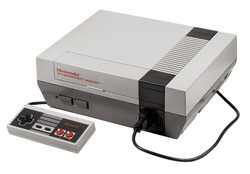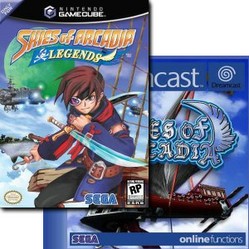
The Evolution of Diving Games
by tirial
Diving games have moved from side scrollers to full 3D renderings of underwater worlds. Here's a history of their evolution and a few classic games.
An Introduction to Diving Games
Diving has been glamorised since the early days of lead weights and diving bells. Linked in popular imagination to action, adventure, dangers and excitment, even people who can't afford to dive themselves are familair with the media portrayals, from James Bond to Open Water. Many action games, like the Tomb Raider series, include diving sections. However few games have been produced where the entire gameplay is built around diving.
Endless Ocean, the launch title for Nintendo's Wii console is probably the first one to come to mind. However Arika, the studio behind it, had already created well-regarded diving games for the PS2, and the history of diving games goes back further, before consoles to home computers like the Atari and BBC.
2D Scrollers
The first diving games
The first diving games were flat two-dimensional scrollers. Usually your diver just moved across the screen in the manner of many platformers and side-scrollers of the time, collecting items or resolving "underwater" mazes. There were exceptions: Mar Tesoro for the Atari had complex multi-stage gameplay, but these were unusual. Many were simply reskinned space games.
Regardless there were quite a range, from the imaginatively titled "Scuba Dive" for the Commodore 64 and Spectrum to Olympics games for the BBC and Atari.
The Next Generation
Basic 3D on the Playstation
With the creation of game consoles,more complex diving games could come out. However, the studios seemed to have little interest in exploration.
The best known diving game for the Playstation was Diver's Dream (also released as Dolphin's Dream or originally G-Shock) by KCE Sapporo who are now part of Konami. A rather rare game, very few gamers heard of it and it had a limited release.
Rendered in 3D, you controlled your third-person rendered diver to perform underwater missions. To get funds you salvaged items from the sea-floor or performed missions. Unfortunately there seemed to be concerns that a game focused purely on salvage diving would not sell. A plot about a mystical artefact was added which some reviewers compared to Resident Evil in a sunken ship. Sadly it tried to be all things to all people and failed: the action horror fans were put off by the diving, the diving fans hated the horror and everyone hated the controls.
Despite its poor release and reception, Diver's Dream had many things in common not with the next generation of games, but with the ones after that.
About Diver's Dream
Also called Dolphin's Dream and G-Shock
Diver's Dream on Amazon.co.uk
With very limited Availability, this game is sometimes available from Amazon.co.uk
Divers Dream
Video by PSXMemories
Diver's Dream
As an early game, released by Konami's KCE Sapporo studio, the game is now very dated. The above ground interface uses basic models and static displays and underwater there are a lot of sawtooth edges. However, it does have atmosphere, and the creatures are well designed, even if occassionally unrealistic. Nonetheless, despite it's limits, it showed what could be done with the idea and while original copies are hard to find, it did get a re-release in Konami's value series.
Unfortunately, perhaps because of the game's poor reception, no one picked up the theme and ran with it, and so the idea languished unused until the advent of the PS2.
True 3D and the Everblue generation
Diving Games on the second generation consoles
On August 9, 2001, a small studio called Arika released their first diving game. Everblue, for the PS2 got a limited release in the UK and Europe and, oddly, never made it to the US.
The sequences on land were a basic two dimensional point and click layout for various parts of town. In the water, the game came to life in a beautifully rendered fully threedimensional world. Gameplay was first person, giving you an immediacy lacking in Diver's Dream, and a chance for some beautiful closeups or the creatures. With no dangerous creatures in the waters off Daedalus Island, there was plenty of tension when exploring sunken wrecks, and always keeping a eye on your air meter. Although the game was scuba diving, the engine had some limitations on vertical movement - for example you could not look straight up.
This caused some questions about whether Leo, the hero, was wearing flippers or weighted boots and a diving suit. (The question is answered if you watch the came carefully: there is one section where he swims up a lift shaft with no ladder or other aid.)
The game was a hit, despite its limited release. The creatures were outstanding rendered, it was a new idea, and the gameplay worked. The plot all revolved around salvage diving, the island's main industry, and Leo had to find items for people or to sell in order to upgrade his equipment. The unusual use of sonar - mimicked by an actual ping-and-return sound - made it an ideal if frustrating game for treasure hunters.
It was popular enough that a sequel was commissioned.
Everblue in Play
The first true diving game
As you may notice underwater motion is somewhat limited vertically. It is difficult to move up or down freely, perhaps because of the standard 3D first person engine in use. However the fish are beautifully rendered, and the experience is thrilling.
While no fish in the game are dangerous, getting stuck in a sunken wreck as your air meter ticks down can be terrifying.
Amazon.co.uk: Everblue (PS2)
Everblue Gameplay
The Japanese version of Everblue
Everblue 2
Arika's second game.
Everblue was quickly followed by Everblue 2 in 2003. Although not one of Capcom's main titles, it got a worldwide release.
The above ground sequences had been improved, and the individuals animated properly. The underwater world was another vast step forward. Improved 3D movement, particularly within wrecks, made exploration a much more complex experience. Climbing through windows, ducking under tables and swimming through crates all brought a real sense of being underwater. The screen furniture changed slightly, but the main gameplay was unchanged: using the sonar to find items for salvage and to complete quests. The plot was more complex, with multiple subquests, and a strong cast of supporting characters. The addition of rivals, enemies and dangerous sea creatures made it a more complex game.
With Everblue 2, diving games became more of a niche in their own right. It proved a phenomenally popular game, but due to its lack of publicity and small launch it is now hard to find. The game has a high replay value, and many gamers have held on to their copies. However one large company did take notice, for their next generation console.
Everblue 2 Gameplay Sample
An advance in graphics and true 3D
Everblue 2
Better freedom of movement, better above ground graphics and a more detailed plot. Everblue 2 built on the first game and created the first Diving game to get a worldwide release.
 | Everblue 2Only $44.99 |
The third generation of consoles
From Everblue to Endless Ocean
On the strength of the Everblue series, Arika were contracted by Nintendo to produce a launch title for their upcoming Wii console (then the Nintendo Revolution). The result was released 9 Nov 2007. Endless Ocean in some ways took a step back. Like Diver's Dream, the diver (and their companions) appeared on screen in third person and items showed up as glints on the sea floor. There was no sonar. However this was where the simularities ended.
Endless Ocean's original title was Forever Blue, but it was renamed due to marketing concerns. Above ground, again the game was minimalist. However once underwater, the graphics were stunning, taking advantage of the Wii's higher capabilities. The Wii-mote allowed for easy control of your diver on-screen, replacing the awkward third person controls of the earlier game. The plot was thin and short, but then the plot wasn't the focus of the game. As the tagline said: Dive, Discover, Dream.
Endless Ocean trailer
Dive, Discover, Dream...
...And a generation of gamers did. This was something different - so different that the original Endless Ocean is still a highly collectible game years after it came out.
 | Endless Ocean: Dive, Discover, Dream Discover the beauty of the sea and take part in various activities such as swimming, exploring marine life or cataloguing tropical fish with this new Touch! Generations title. ... Only $19.9 |
Endless Ocean 2
In February 2010, its sequel was released. Just as Everblue 2 had, this expanded on the first game's gameplay and methods, although it was not a direct sequel.
Endless Ocean 2 added dangerous animals and a worldwide scope with diving locations around the globe. With new regions to explore, new creatures to find, and the return of the sonar the game offered more replay value than its predecessor. The plot was more developed, although in places it can seem linear.
It isn't without flaws: Sub plots like dolphin training, an acquarium and mysterious creatures like cryptids all expand the game's reach once you have finished the plot, but some of them are permanently ongoing, and for others (dolphin training) you can effectively set the Wii on auto and leave it playing itself for hours while you go and do something else.
Nonetheless, it remains a gorgeous game.
The Future of Diving Games?
At the time of writing Endless Ocean 2 is the latest release for diving games, but there have been other spin-offs. Sea Monsters on Wii and DS, a spin off from the TV series, sees the player take control of prehistoric fish instead of a diver and hunt fossils instead of relics.
We can only wait to see what Endless Ocean 3 would offer - or if another studio will take up the challenge.
Endless Ocean 2: Blue World
 | Endless Ocean: Blue World Dive into the beautiful and fascinating undersea world of Endless Ocean: Blue World! Travel across the globe--dive in exotic locations, enjoy interacting with over 350 ... Only $42.99 |
Creative Commons Licence
Originally my article from Bukisa, I have updated it and re-released it here. This article is not for free distribution without attribution. If you want to reprint it, please link to either page and credit the actual author.
The original can be found here:
An Evolution of Diving Games written by tirial on bukisa
More links about Diving Games by this author
The Endless Ocean series
The Endless Ocean games
The Everblue Series
The PS2 Everblue series of games, which gave Arika the basis for Endless Ocean
An Evolution of Diving Games
The original version of this article, with less detail, on Bukisa
You might also like
Once A Year: NES GamesWhat if you could only have one Nintendo Entertainment System Game for every ...
Skies of ArcadiaAn epic RPG with discovery elements, Skies of Arcadia was first released on D...



 Alternatives to Tweetdeckon 03/06/2015
Alternatives to Tweetdeckon 03/06/2015
 Computer Game reviewson 02/28/2015
Computer Game reviewson 02/28/2015
 The Bard's Taleon 02/04/2015
The Bard's Taleon 02/04/2015
 Domeboon 02/04/2015
Domeboon 02/04/2015



Comments